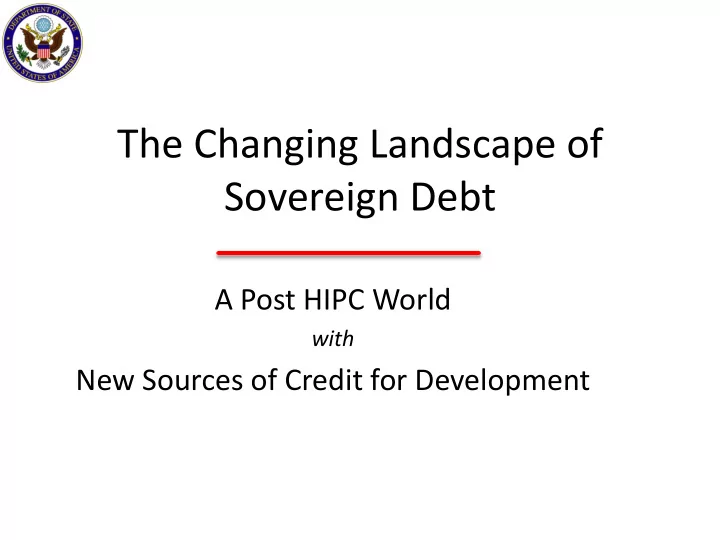

The Changing Landscape of Sovereign Debt A Post HIPC World with New Sources of Credit for Development
Financing for Development The ability to raise significant domestic revenue… …results in greater control over policy decisions and the development agenda.
Domestic Financing for Development (DF4D) Mobilize domestic tax revenue Sound Public Financial Management Fight Improve corruption transparency
HIPC Nearing Completion – Debt Burden Removed To date 36 countries have qualified for debt stock reduction of $127 billion. Status of Highly Indebted Poor Countries as of March 31, 2013 Pre Decision Point Decision Point Completion Point Completion Point Afghanistan Honduras Eritrea Chad Benin Liberia Somalia Bolivia Madagascar Sudan Burkina Faso Malawi Burundi Mali Cameron Mauritania Central African Republic Mozambique Comoros Nicaragua Cote d’Ivoire Niger Dem Republic of Congo Rwanda Republic of Congo Sao Tome and Principe Ethiopia Senegal Gambia Sierra Leone Ghana Tanzania Guinea Togo Guinea-Bissau Uganda Guyana Zambia Haiti Unsustainable Debt Sustainable Debt Source: IMF
Debt Sustainability Restored The debt burden of HIPC countries declined rapidly after completion point. External Public Debt for HIPC Post-Completion Countries Percentage of Debt to GDP The Year in which HIPC 120 countries reached completion point . 100 80 Percent 60 40 20 0 CP-4 CP-3 CP-2 CP-1 CP CP+1 CP+2 CP+3 CP+4 Source: IMF staff calculations *Countries that reached HIPC completion point in 2006 or earlier. The post-completion point period includes debt relief from MDRI.
Poverty Spending Up – Debt Service Down
Changes in Emerging Market External Debt Official Creditors Expand Beyond the Paris Club… 1994: US$ 600B 1978: US$ 96.6B Other Official Bilateral (2.15%) IFIs (25.5%) IFIs (33.55%) Paris Club (74.5%) Paris Club (64.3%) Source: IIF
Changes in Emerging Market External Debt To a new normal which requires expanding cooperation…. 2011: US$ 1,020 2008: US$ 795B Other Other Bilateral Bilateral (20.2%) (22.5%) IFIs (36%) IFIs (38.3%) Paris Club Paris Club (41.5%) (41.5%) Source: IIF , Paris Club
Changing Structure of Official Development Assistance (ODA) Fewer loans, more grants, & emerging donors… Net ODA Net ODA 2009 1994 US$ 126.7 Billion US $ 59.2 Billion Emerging Donors (5.2%) Contributi ons to IFIs Contributions (30.2%) to IFIs (28.8%) Bilateral Grants (59.5%) Bilateral Bilateral Grants Loans (63.8%) (10.3%) Bilateral Loans (2.2%) Source: World Bank
Changing Structure of Developing Country Debt Private credit now dominates… 2009 1970 Bi-lateral Creditors 15% Bi-lateral Creditors Commercial Multilateral 42% Creditors Creditors 46% Commercial 19% Creditors 66% Multilateral Creditors 12% Debt Stock = $2 trillion Debt Stock = $57 billion Source: UNCTAD
The new era of private capital flows global capital flows to emerging market economies 2011 US$ 1,145B 1980 US$ 60.2 B Net Official Flows (5.4%) Net Official Flows (22%) Net Private Flows (78%) *of which Paris Club 12% Net Private Flows (94.6%) Source: IIF , World Bank *of which official Bilateral creditors 3.9%
Shift in Principal Official Trade Creditors 2011: US$ 142B 2002: US$ 46B BIC (22.8%) BIC (45.6%) G-7 (54.4%) G-7 (77.2%) *of which China 20% *of which China 35% Source: US EX-IM Bank
Today’s Major Sovereign Creditors Cumulative New Medium and Long Term Official Export Credit Volumes: 2006-2011 280 240 200 160 120 80 40 0 China Germany France US Brazil India Italy Japan
Post-HIPCs also tap international capital markets • Eurobonds : Ghana, Cote d’Ivoire, Republic of Congo, Senegal, Namibia, Zambia. • Potential Eurobond issuers : Rwanda, Uganda, Tanzania, Mozambique. • Highlights importance of fiscal sustainability and the declining importance of sovereign lending. • Grants still a large part of investment by African governments.
2012 Fiscal Balance (% of GDP) vs 2012 Public Debt (% of GDP) (source: IMF WEO, except Ghana) 90 Mauritania São Tomé and Príncipe 80 70 Cote d'Ivoire 60 Madagascar Debt as % of GDP Malawi 50 Ghana Kenya Senegal Tanzania Mozambique 40 South Africa Uganda Sierra Leone Burundi DRC Liberia 30 Burkina Faso Angola Rwanda Zambia Republic of Congo Ethiopia 20 Cameroon 10 0 -15 -10 -5 0 5 10 2012 Deficit as % of GDP
10 15 20 25 Source: Paris Club 0 5 1956 1958 1960 1962 1964 Paris Club then and now 1966 1968 1970 1972 1974 Paris Club Agreements 1976 1978 1980 1982 1984 1986 1988 1990 1992 1994 1996 1998 2000 2002 2004 2006 2008 2010 2012
Recommend
More recommend